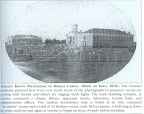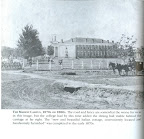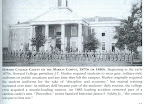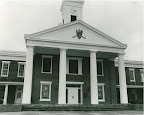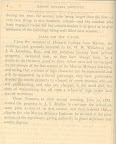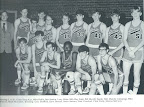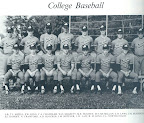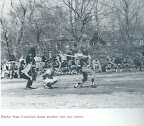The Board of Trustees of Howard College reluctantly agreed in August, 1863, to offer its property to the Confederate government to establish Breckinridge Division Hospital, but referred to generally as Breckinridge Military Hospital.
The Howard College campus that was Breckinridge Military Hospital from 1863 - 1865. The image is from the late 1860s or early 1870s. (Samford University Special Collections)
A drawing of the Howard College/MMI Chapel from an old postcard. (MMI Archives)
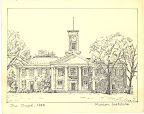
The College Chapel was converted into a major wing of the hospital, the pews being used by the more seriously ill patients, with the other rooms serving as administrative offices and operating rooms. The two dormitories were named Wards A and C, and were utilized by the less seriously ill soldiers. A tent encampment for the overflow of patients dotted the front campus.
An old image of the interior of The Chapel. Note the balconies on either side and the two pot-bellied stoves with piping. (MMI Archives)

Drs. William Augustus Evans and James McCown Greene were placed in charge of Breckinridge Hospital. However, one Willie Banks, an African American slave woman who served as the night nurse at the hospital, claimed that Dr. John Thomas Barron of Marion (a member of the first graduating class at Howard College), was actually the medical officer in charge.
Most of the hospital records were lost or destroyed. However, one existing volume (now at Samford University) from August, 1863, to December, 1864, indicates that there were 406 patients at the hospital. The number of soldiers who died is unknown (many remains were sent back to their homes), but 102 graves were once located in a pine grove behind the College Chapel. Following the Civil War, these graves, including the unknowns, were re-interred in the cemetery of St. Wilfrid’s Episcopal Church in Marion.
The Confederate cemetery at St. Wilfrid’s Episcopal Church in Marion. (Photo by Mark Griffiths)
Federal troops entered Marion from Selma in early April, 1865. They took over Breckinridge Hospital and paroled the remaining Confederate soldiers there and in town, the war being essentially over. With Union troops occupying the College buildings, one dormitory was designated to house freed slaves from Perry County planters, a move strongly protested by the Howard College Board of Trustees.
